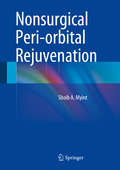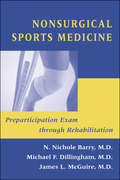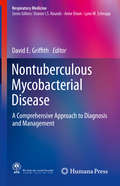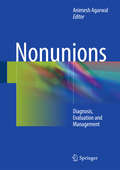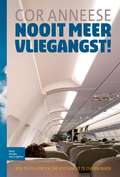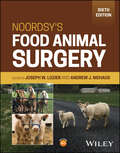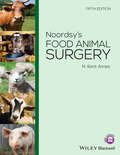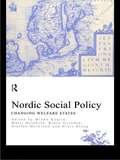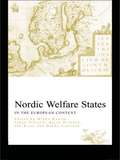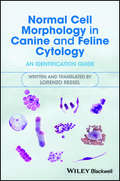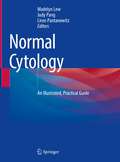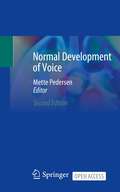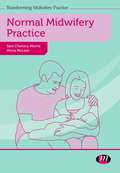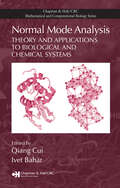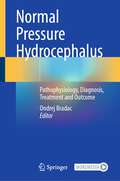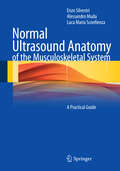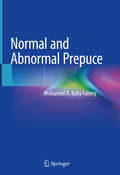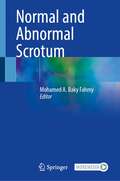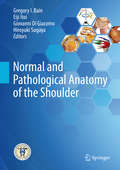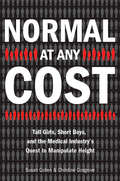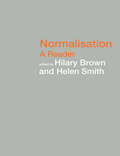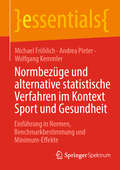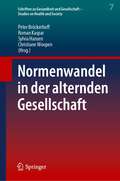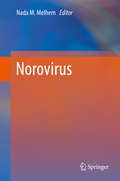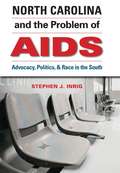- Table View
- List View
Nonsurgical Peri-orbital Rejuvenation
by Shoib A. MyintThis book offers surgeons the most up-to-date information related to non-surgical techniques specific to periorbital rejuvenation. This easy-to-use reference guide is for ophthalmologists, oculoplastic surgeons, dermatologists, plastic surgeons, maxillofacial and plastic surgery residents, as well as ENT facial plastic fellows. Complete with videos of specific techniques to better inform surgeons about these evolving procedures, Nonsurgical Peri-orbital Rejuvenation teaches the reader how to measure predictable outcomes when deciding to approach the periorbital area. Topics covered include neurotoxins, peels, lasers, fillers, and skinceuticals.
Nonsurgical Sports Medicine: Preparticipation Exam through Rehabilitation
by N. Nichole Barry Michael F. Dillingham James L. McGuireWith a growing number of people, young and old, engaged in a variety of physical activities, the field of sports medicine has gained greater importance for medical professionals. Nonsurgical Sports Medicine provides a comprehensive guide for the physician whose practice includes preparing patients to take part in sports as well as diagnosing and treating any resulting injuries. Nonsurgical Sports Medicine begins with an overview of the principles of the preparticipation medical evaluation and outlines how preexisting medical conditions may be optimally managed in the athlete. Individual chapters cover the evaluation and treatment of head and spine injuries, injuries to the upper and lower extremities, and overuse syndromes. The book also addresses such important issues as infectious diseases, ergogenic agents, the needs of older and young athletes, women in sports, and the effect of environmental conditions on athletes. Along with detailed discussions of the anatomy and physiology of the musculoskeletal system, the authors describe specific maneuvers during the physical examination which are important for evaluation and diagnosis. Nonsurgical Sports Medicine provides a broad range of information that complements a physician's general knowledge and that will be invaluable in assessing patients with sports-related injuries.
Nontuberculous Mycobacterial Disease: A Comprehensive Approach to Diagnosis and Management (Respiratory Medicine)
by David E. GriffithThis book is a comprehensive and authoritative source on nontuberculosis mycobacterial (NTM) pathogens and diseases and their appropriate management, with a focus on lung disease. NTM diseases, especially lung diseases, are increasing in prevalence in the U.S. and internationally with concomitant growing interest in a broad section of the medical community. Often merely included in coverage of tuberculosis, many aspects of NTM organisms and diseases are actually very different than TB. These differences are not intuitive or trivial and frequently result in suboptimal management of NTM patients. This book addresses these gaps in the literature with chapters on microbiology, pathophysiology, epidemiology, the various diseases that can stem from NTM, and their particular management. There is also coverage on prevention and NTM as a public health problem. For pulmonologists and infectious disease physicians, this is the definitive resource on nontuberculosis mycobacteria.
Nonunions
by Animesh AgarwalProviding a comprehensive presentation of the diagnosis, evaluation and management of nonunions, this generously illustrated text details the current principles, surgical techniques and approaches with these challenging clinical situations. Since each nonunion can be fairly particular, the treatment regimens provide guidelines to effectively approach such problems. Opening with a discussion of the principles of nonunions and fracture healing, the remainder of the book is divided by anatomical area and provides evidence-based recommendations, case examples, and preferred treatment/algorithms for both the upper and lower extremities, including the clavicle, the proximal humerus, proximal femur, and tibial plateau, as well as the pelvis and acetabulum. Specialized circumstances are also discussed, including periprosthetics and joint replacement. Although not every single treatment option is described for every single anatomical area and type of injury, Nonunions is an excellent resource for orthopedic trauma surgeons, residents and students, not only for managing these common yet complex problems but also in preventing nonunions from occurring by avoiding surgical causes and mitigating patient risk factors.
Nooit meer vliegangst
by Cor AnneeseEen op de drie mensen is bang om te vliegen, ondanks het statistische gegeven dat vliegen 250 keer veiliger is dan reizen per auto. Er bestaan verschillende vormen van vliegangst. De angst om neer te storten is er slechts een van. Veel mensen nemen een angst of fobie die hun dagelijks parten speelt mee op reis. Heb je last van hoogtevrees? Dan vind je het waarschijnlijk lastig om in een vliegtuig bij het raampje te zitten. Als je in het dagelijks leven last van engtevrees hebt, is de kans groot dat je ook in een vliegtuig een benauwd gevoel krijgt. Misschien raak je zelfs in paniek uit angst voor die angst. Nooit meer vliegangst! biedt iedereen die op een of andere manier last van dergelijke angstklachten heeft een effectieve aanpak om daarvan af te komen. Het geeft informatie over allerlei technische aspecten van het verschijnsel 'vliegen' en laat zo zien dat je vliegangst niet nuttig of realistisch is, maar alleen wordt veroorzaakt door je eigen gedachten. De duidelijk beschreven oefeningen in dit zelfhulpboek geven je inzicht in het ontstaan van je angst. De ontspanningstechnieken zijn gemakkelijk toepasbaar in allerlei situaties. De herkenbare verhalen van ervaringsdeskundigen maken dit boek bovendien prettig leesbaar en extra toegankelijk.
Noordsy's Food Animal Surgery
by Andrew J. Niehaus Joseph W. LozierFully updated new edition of a classic quick reference to common surgical procedures in farm animals Noordsy’s Food Animal Surgery, Sixth Edition is a classic quick reference to surgical procedures in livestock and companion farm animals. With a practical outline format, this book makes it easy to locate essential information on common surgical techniques, presenting 39 chapters across 6 sections for ease of navigation. The book is a helpful memory refresher for procedures or species encountered less frequently, enabling readers to build confidence in learning new surgical techniques. Chapters review presurgical preparation, perioperative care and restraint, and surgical procedures of the major body systems, and the Sixth Edition has been updated throughout to remove outdated procedures and equipment, making way for new techniques and a focus on evidence-based best practices. Most illustrations have been updated to more accurately depict anatomy, providing surgeons with a clearer understanding of how to perform the procedures, and numerous clinically relevant photographs and illustrations have been added to better convey concepts and techniques. A companion website allows readers to view and download figures from the text and contains study questions from the end of each chapter along with the answers to those questions. Noordsy’s Food Animal Surgery includes information on: Surgical restraint, local, epidural, general, and postoperative anesthesia/analgesia, surgery of the head and neck, and surgical treatment of cattle with ocular diseaseUmbilical hernias and infections, laparotomy, rumenotomy, fistulation, cannulation, pericardiotomy in cattle, abomasal surgery, surgical treatment of intestinal disease, and rectal prolapse repairSurgical treatment of the male and female urogenital systems including conditions associated with urolithiasis and mammary surgeryLigament and tendon surgery, foot and claw surgery, joint surgery, and common fractures and dislocations Noordsy’s Food Animal Surgery is an essential resource for veterinary students and large animal practitioners who care for farm animals.
Noordsy's Food Animal Surgery
by N. Kent AmesNoordsy's Food Animal Surgery, Fifth Edition is a fully updated new edition of the classic field manual on surgical techniques in cattle, goats, sheep, and pigs. Designed for easy, fast access in the field, information is presented using a concise outline style with information boxes, tables, drawings, and photographs to highlight and illustrate key points Noordsy's Food Animal Surgery is an ideal reference for veterinary students and clinicians seeing food animal patients.Beginning with chapters on general surgical considerations, restraint, and anesthesia, the book's main focus is on step-by-step procedures for specific surgical techniques. The Fifth Edition has been thoroughly updated throughout to provide a current resource, with additional information on welfare, pain management, and anesthesia. Noordsy's Food Animal Surgery is an essential purchase for practitioners and students wanting to develop or refresh their surgical skills.
Nordic Social Policy: Changing Welfare States
by Bjørn Hvinden Mikko Kautto Matti Heikkilä Staffan Marklund Niels PlougBy focusing on developments in the Nordic welfare states during the past decade, Nordic Social Policy provides new insights into the evolution of welfare state measures and generally assesses the peoples health in Sweden, Finland, Norway and Denmark. This comparative work includes chapters on *the changed preconditions of welfare policies *changes in the welfare measures *developments in the welfare of the people *developments in public support for the welfare states.
Nordic Welfare States in the European Context
by Johan Fritzell Jon Kvist Bjørn Hvinden Mikko Kautto Hannu UusitaloThis important sequel to Nordic Social Policy (Routledge 1999) compares welfare state development over the last twenty years in Denmark, Finland, Norway and Sweden with that of Germany, the Netherlands, the United Kingdom and other Western European countries. Topics covered include: * income distribution, health inequalities and gender equality * gender policies, health and social care services and policy reaction to family changes * social security and employment policies * financing of welfare states. In the context of globalisation, ageing populations, changing employment patterns and rising inequalities, Nordic Welfare States in the European Context offers an empirical analysis of welfare adaptations and a lively discussion of the historical development of European social policy. It finds a greater ambiguity regarding variation and trends than is commonly suggested. Contrary to expectation, there is little evidence of the Europeanisation of Nordic welfare states, rather the reverse. The comparable and empirical data used in this study make it a unique contribution to understanding current trends in European social policy.
Normal Cell Morphology in Canine and Feline Cytology: An Identification Guide
by Lorenzo ResselA concise and practical visual guide to normal cell identification for all those dealing with cytology in the dog and cat. Normal Cell Morphology in Canine and Feline Cytology: An Identification Guide takes a uniquely visual approach to normal cell identification in dogs and cats. Single-page presentations offer vivid snapshots of particular cell types, with high quality microphotographs matched with annotated schematic diagrams and accompanying explanatory text. Providing a vital understanding of what normal cells look like, this text is ideal for all those in small animal veterinary practice examining cytology samples. The book begins with a concise, yet comprehensive introduction to the principles of morphological identification, followed by a description of the distribution of cells and where different cell types can be sampled from in the various tissues and organs. The main part of the book is devoted to describing each cell type and its characteristics. Cytoarchitectures, observed non-cellular material and general pathological changes are also described. Offers a unique alphabetically organised visual guide to each cell type, covering cells from every type of organ and system Features an abundance of full-colour microphotographs accompanied by beautifully rendered schematic diagrams, making cell identification quick and easy Includes a visual index for ultimate ease of navigation at the microscope Normal Cell Morphology in Canine and Feline Cytology is a must-have text for veterinary students and an indispensable bench manual for small animal veterinary practitioners.
Normal Cytology: An Illustrated, Practical Guide
by Liron Pantanowitz Madelyn Lew Judy PangIn the practice of cytopathology, cytologists frequently encounter a spectrum of benign, normal cells in samples. In fact, these normal cells frequently comprise the greatest proportion of material present on a cytology slide. This is frequently the case in Pap smears of the uterine cervix , urine samples, and lung samples such as bronchial brushings. Normal cytology can often mimic pathology leading to misdiagnoses, especially in cases with reactive and metaplastic changes. Moreover, cytopathology findings of certain neoplasms can also mimic normal cytology.Today, cytology laboratories are no longer confined to dealing with just exfoliative specimens and superficial aspirations. With interventional radiology as well as endobronchial and endoscopic ultrasound-guided fine needle aspirations (FNA), we increasingly encounter visceral samples. Hence, cytologists are even likely to encounter normal elements from deep-seated organs. Sometimes, unexpected normal elements may be found within cytology specimens because a FNA procedure has contamination or inadvertently sampled a nearby organ or normal anatomical structure. A typical example is the finding of ganglion cells when a FNA is performed targeting a celiac node for cancer staging (Elgarby EA et al. Frequency and characterization of celiac ganglia diagnosed on fine-needle aspiration. Cytojournal. 2015; 12:4). Despite the importance of knowing the spectrum of normal cytology, there are limited reference materials available on this topic for cytologists. Most cytopathology texts deal with abnormal cytology. Often, the chapters in these books only devote a few sentences about normal cytology (euplasia). Our proposed book intends to fulfil this need. The book will contain a mixture of text and images (atlas). Important aspects related to cytology practice will be highlighted such as clinical relevance, differential diagnoses, mimics and pitfalls. The images will include a variety of cytology specimen preparations (e.g. direct smears, liquid based samples, touch preparations, cell blocks) and stains (e.g. Diff Quik/MGG, Papanicolaou, H&E). In selected cases, the expected immunoprofile of normal cells will be addressed. Each chapter will also include a modest list of helpful and contemporary references.
Normal Development of Voice
by Mette PedersenThis fully revised and extended second edition provides a comprehensive, most up-to-date overview of the investigation of quantitative measurement in the complex of voice. Important objective parameters of normal voice development are assessed, especially relevant when pathological deviations have to be recognized and defined. The description of different qualities of normal voice development in terms of measurable parameters is provided. The book highlights the hormonal changes that have a considerable influence on the physical development of boys and girls, and how it is possible to predict the voice transition statistically. The extent to which hormones affect voice development in the two genders are made clear in this work through the observation of a number of parameters. In this second edition, the focus is extended to include High-Speed Video images and further discussion. Possible interesting topics for further research are also emphasized. This book will be a valuable resource for laryngologists, phoniatricians, and teachers in their daily work.This is an open access book.
Normal Midwifery Practice (Transforming Midwifery Practice Series)
by Sam Chenery-Morris Moira McLeanFor new students the language and concepts of midwifery care can at first be daunting. This book helps students to understand the expectations of midwifery training in relation to normal midwifery practice. It covers the basics of midwifery care including professional practice, frameworks informing midwifery care, key concepts and philosophies of care, communication and care skills, antenatal care, normal labour and birth, postnatal care, neonatal care and breastfeeding, as well as a brief introduction to medicines management in normal midwifery care. The book is designed to work alongside first taught modules in midwifery, and underpin training in subsequent years.
Normal Mode Analysis: Theory and Applications to Biological and Chemical Systems (Chapman & Hall/CRC Mathematical Biology Series)
by Qiang Cui Ivet BaharRapid developments in experimental techniques continue to push back the limits in the resolution, size, and complexity of the chemical and biological systems that can be investigated. This challenges the theoretical community to develop innovative methods for better interpreting experimental results. Normal Mode Analysis (NMA) is one such technique
Normal Pressure Hydrocephalus: Pathophysiology, Diagnosis, Treatment and Outcome
by Ondrej BradacThis book provides a detailed practically focused guide on the latest diagnostic and treatment techniques available for normal pressure hydrocephalus (NPH). Chapters in this work cover the latest developments related to this condition. It introduces how to use a range of diagnostic modalities including magnetic resonance scanning along with how artificial intelligence and machine learning methodologies can be applied. Cases are presented to reinforce how the methods covered can be appropriately applied and guiding principles are also given to assist the reader in developing a thorough understanding of the topic. Potential complications and means of mitigating these are also described. Normal Pressure Hydrocephalus is a detailed practically applicable resource on NPH with insightful contributions covering relevant aspects of pathophysiology, diagnostic modalities and treatment strategies, making it an ideal resource for all medical practitioners who encounter these patients.
Normal Ultrasound Anatomy of the Musculoskeletal System
by Enzo Silvestri Luca Maria Sconfienza Alessandro MudaThe book provides a comprehensive description of the ultrasound anatomy of the musculoskeletal system and clear guidance on the technique. Ultrasound images are coupled with anatomic pictures explaining probe positioning and scanning technique for the various joints of the musculoskeletal system: shoulder, elbow, hand and wrist, hip, knee, foot, and ankle. For each joint there is also a brief explanation of normal anatomy as well as a list of tricks and tips and advice on how to perform the ultrasound scan in clinical practice. This book will be an excellent practical teaching guide for beginners and a useful reference for more experienced sonographers.
Normal and Abnormal Prepuce
by Mohamed A. FahmyThis illustrative book discusses the normal embryology, anatomy, functions, normal variations and diseases affecting the prepuce. It also explores other rare anomalies and diseases of the prepuce as well as previously unreported cases. In addition to the male prepuce, the book also discusses the female prepuce (hood) in order to elucidate some lights in normal and abnormal prepuce. A separate section covers the frenulum and its anomalies. Rich in illustrations this book will help paediatricians and urologists better understand the anomalies of the prepuce.
Normal and Abnormal Scrotum
by Mohamed A. Baky FahmyThis book is an academic and practical guide to the diagnostic methods and management strategies for both common and rare scrotal diseases. Chapters focus on the normal anthropometric measures of the scrotum as a unique organ and the latest relevant advancements in the field. Techniques including scrotal reconstruction for congenital abnormalities, trauma, and cancer-related extirpation are all covered. Critical tools and methods related to aesthetics are also detailed. Emphasis is also placed on identifying common pitfalls and how to avoid them, ensuring that the reader is fully equipped to deal with a range of scenarios.Normal and Abnormal Scrotum describes how to approach diagnosing and managing the entire range of scrotal diseases, making it essential for all general practitioners, pediatricians, urologists, and pediatric and aesthetic surgeons who encounter these patients in their day-to-day practice.
Normal and Pathological Anatomy of the Shoulder
by Eiji Itoi Gregory I. Bain Hiroyuki Sugaya Giovanni Di GiacomoThis cutting-edge monograph on advanced clinical anatomy and pathoanatomy of the shoulder, written by the world's leading authors, reflects recent significant advances in understanding of anatomy and pathology. It is beautifully illustrated with exquisite photographs of anatomical specimens, and images from arthroscopy, histology, and radiology complete the picture. The accompanying text brings out the clinical, biomechanical, and functional relevance and focuses on aspects important to the high-performance athlete. In addition, the book closely assesses how each component of the normal anatomy responds to trauma, disease, and degeneration. The finer points of the pathoanatomy are demonstrated with clinical cases, histology, radiology, arthroscopy, and open surgery. The text details how the pathoanatomy affects the patient presentation, clinical examination, and imaging. It is also explained how the pathology affects the natural history and the outcome of physical therapy and influences recommendations for surgical treatments. This book will be of immense value both to trainees and to specialists who manage disorders of the shoulder, including orthopedic surgeons, sports physicians, and physiotherapists. It will also be of great interest to anatomists and pathologists.
Normal at Any Cost
by Susan Cohen Christine CosgroveA fascinating story of medical experimentation, parental love, and the extreme measures taken to make children fit within ?the norm.? Most people rarely think about their height beyond a little wishing and hoping. But for the parents of children who are ridiculed by their peers for being extraordinarily tall or extraordinarily short, height can cause great anguish. For decades, the medical establishment has responded to these worries by prescribing controversial treatments and therapies for children who fall outside of the ?normal? height range. While some have benefited, many have suffered from devastating side effects. In this riveting book, Susan Cohen and Christine Cosgrove provide a voice for the parents, doctors, scientists, and pharmaceutical companies involved in these experimental treatments. They also tell the story of the boys and girls themselves, many of them now grown, who were subjected to a wide range of non-FDA-approved medical procedures. These treatments? which consisted of extreme doses of estrogen, pituitary glands taken from both animals and human cadavers, and testosterone injections?often had disastrous side effects. Who is to say how tall is too tall, and how short is too short? For many of the individuals represented in this book, the answers have been clear?and they are grateful to the medical industry for improving upon nature. For others, left in the wake of this same science, the answers are fueled by tragic regret. The authors explore the dueling motives behind these procedures? with parents desperate to help their children ?fit in? and doctors and scientists hungry for scientific breakthroughs. Combining extensive research and in-depth interviews, Normal at Any Cost is the first book to place a human face on this complex and ethically charged medical history.
Normalisation: A Reader
by Hilary Brown and Helen SmithNormalisation, the theoretical framework that underpins the movement of services for people with disabilities from long stay hospitals, has recently become the focus of much academic and professional attention. As the community care debate has moved into the public arena, it has attracted a certain amount of criticism, acknowledging the political and philosophical conflicts that surround it. Normalisation: A Reader for the Nineties provides a much needed, informed appraisal of this controversial practice and combines various perspectives on the subject, including applied behavioural analysis, social policy and psychodynamic approaches. Thus it explores the discrepancies between the ideal and the reality and extends the debate by drawing comparisons, with other political and social ideologies.
Normbezüge und alternative statistische Verfahren im Kontext Sport und Gesundheit: Einführung in Normen, Benchmarkbestimmung und Minimum-Effekte (essentials)
by Michael Fröhlich Andrea Pieter Wolfgang KemmlerIm Sport und im Gesundheitswesen sind Normen, Normwerte und Normwertbezüge wesentlich, wenn es darum geht, Informationen zu sportlichen, physiologischen, psychologischen und/oder gesundheitlichen Kenngrößen qualitativ und quantitativ einzuschätzen. Einfache und etablierte Verfahren und Methoden zu deskriptiven, graphischen und numerischen Normwertdarstellungen sowie zu alternativen statistischen Verfahren der Normwerteinschätzung werden erläutert.
Normenwandel in der alternden Gesellschaft (Schriften zu Gesundheit und Gesellschaft - Studies on Health and Society #7)
by Christiane Woopen Peter Bröckerhoff Roman Kaspar Sylvia HansenUnsere Gesellschaft wird nicht zuletzt dank anhaltendem Wohlstand und medizinisch-technischem Fortschritt immer älter. In den letzten hundert Jahren ist die durchschnittliche Lebenserwartung um mehr als 30 Jahre gestiegen. In einer Gesellschaft des immer längeren Lebens verändern sich Vorstellungen von Gesundheit und Krankheit, Solidarität und Gerechtigkeit. Dieser Sammelband betrachtet aktuelle Fragestellungen hierzu: Wie können wir die Gesundheit der Menschen fördern und bis ins hohe Alter hinein bewahren? Wie können Freiheit und Selbstbestimmung des Einzelnen gewahrt werden? Welche Werte sollen die Gestaltung des Gesundheitswesens leiten? Und wie kann es gelingen, für alle eine gute Pflege im Alter sicherzustellen? Im Rahmen des vorliegenden Tagungsbandes gehen Expertinnen und Experten aus Wissenschaft und Praxis diesen Fragen nach und präsentieren Debatten, Erfahrungen und Erkenntnisse zur Thematik des längeren Lebens in einer alternden Gesellschaft.
Norovirus
by Nada M. MelhemThis book addresses the molecular biology of noroviruses (NoVs), pathogenesis, viral diversity and its impact on selective pressure, host susceptibility and outbreaks, clinical diagnosis, and the latest advances in the management and treatment of disease caused by NoVs. It offers a detailed analysis of our current understanding of the innate and the adaptive immune responses stimulated by NoVs, and discusses the complexity of the ongoing vaccine development and the urgent need for specific immune correlates of protection to advance the field. This is the first book on noroviruses. Written by leading specialists, it is essential reading for virologists and immunologists.
North Carolina and the Problem of AIDS
by Stephen J. InrigThirty years after AIDS was first recognized, the American South constitutes the epicenter of the United States' epidemic. Southern states claim the highest rates of new infections, the most AIDS-related deaths, and the largest number of adults and adolescents living with the virus. Moreover, the epidemic disproportionately affects African American communities across the region. Using the history of HIV in North Carolina as a case study, Stephen Inrig examines the rise of AIDS in the South in the period from the early spread and discovery of the disease through the late nineties.Drawing on epidemiological, archival, and oral history sources, Inrig probes the social determinants of health that put poor, rural, and minority communities at greater risk of HIV infection in the American South. He also examines the difficulties that health workers and AIDS organizations faced in reaching those communities, especially in the early years of the epidemic. His analysis provides an important counterweight to most accounts of the early history of the disease, which focus on urban areas and the spread of AIDS in the gay community. As one of the first historical studies of AIDS in a southern state, North Carolina and the Problem of AIDS provides powerful insight into the forces and factors that have made AIDS such an intractable health problem in the American South and the greater United States.
